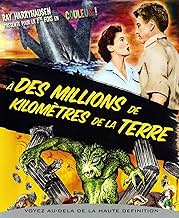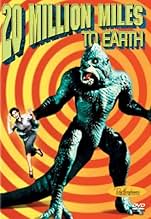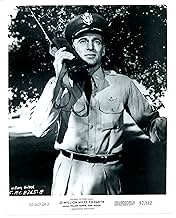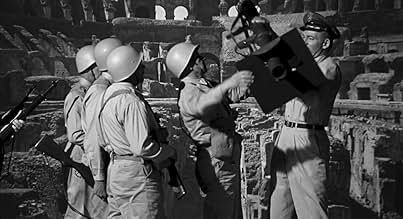AVALIAÇÃO DA IMDb
6,3/10
8,7 mil
SUA AVALIAÇÃO
Adicionar um enredo no seu idiomaThe first U.S. spaceship to Venus crash-lands off the coast of Sicily on its return trip. A dangerous, lizard-like creature comes with it and quickly grows gigantic.The first U.S. spaceship to Venus crash-lands off the coast of Sicily on its return trip. A dangerous, lizard-like creature comes with it and quickly grows gigantic.The first U.S. spaceship to Venus crash-lands off the coast of Sicily on its return trip. A dangerous, lizard-like creature comes with it and quickly grows gigantic.
- Direção
- Roteiristas
- Artistas
Thomas Browne Henry
- Maj. Gen. A.D. McIntosh
- (as Thomas B. Henry)
Bart Braverman
- Pepe
- (as Bart Bradley)
Sid Cassel
- Farmer
- (não creditado)
Neil Collins
- Technician
- (não creditado)
Paul Cristo
- Police Officer
- (não creditado)
Noel Drayton
- 1st Reuters News Correspondent
- (não creditado)
John Duke
- American Embassy Aide
- (não creditado)
Darlene Fields
- Miss Reynolds
- (não creditado)
Duke Fishman
- Fisherman
- (não creditado)
Michael Garth
- Minor Role
- (não creditado)
Ray Harryhausen
- Man Feeding Elephant
- (não creditado)
Avaliações em destaque
Let's state the obvious right off the bat. If it weren't for the stop-motion animation in this film, it would be simply awful. Awful acting, awful script, mediocre direction, this film has it all.
But once the monster appears on screen, none of that matters. Ray Harryhausen's animation is, as always, simply spellbinding, giving the monster, paradoxically, both a heightened reality (as it really is a physical object photographed in "real life") and a dreamlike quality. It's easy to see how Harryhausen's work set the standards for monster special effects until Star Wars and computer animation came along many years later.
This film is a particularly good example of his work for a number of reasons. There's only one monster (unlike the Sinbad/Jason/Titans movies), so all his effort is spent on that one "character". The monster also starts out small and grows huge by the end of the movie, allowing us to see it in a variety of settings. And, the fact that it's a humanoid (rather than a dinosaur or big octopus) allows it to "act" in a much more expressive manner (not unlike the original Kong).
So while this movie may qualify as little more than "MST3K" fodder as a science fiction work (did I mention how truly awful the script is?), as a piece of animation, it's a pure classic, deserving a space on your shelf next to King Kong, Snow White and Fantasia.
But once the monster appears on screen, none of that matters. Ray Harryhausen's animation is, as always, simply spellbinding, giving the monster, paradoxically, both a heightened reality (as it really is a physical object photographed in "real life") and a dreamlike quality. It's easy to see how Harryhausen's work set the standards for monster special effects until Star Wars and computer animation came along many years later.
This film is a particularly good example of his work for a number of reasons. There's only one monster (unlike the Sinbad/Jason/Titans movies), so all his effort is spent on that one "character". The monster also starts out small and grows huge by the end of the movie, allowing us to see it in a variety of settings. And, the fact that it's a humanoid (rather than a dinosaur or big octopus) allows it to "act" in a much more expressive manner (not unlike the original Kong).
So while this movie may qualify as little more than "MST3K" fodder as a science fiction work (did I mention how truly awful the script is?), as a piece of animation, it's a pure classic, deserving a space on your shelf next to King Kong, Snow White and Fantasia.
I think the best thing about this movie is that it's fast-moving. The filmmakers don't waste a lot of time with unnecessary dialog or a sappy romance. They get right to it and stay on track for almost all of the 82 minutes.
Thus, if you like somewhat-hokey 1950s science-fiction movies dealing with space or monsters, or in this case both of them, you should enjoy this little film. Most of it involves trying to cope with a specimen from Venus which quickly grows into a Godzilla-like monster (but smaller).
It seems a space ship had gone to Venus, but crashed on the way home. Only good-guy William Hopper, who used to help Perry Mason win courtroom cases on TV about this same time, survives the crash. The ship lands in a big body of water off Italy. The specimen, about the size of a trout, washes onshore where a little boy finds it and then shows it to his scientist-uncle. Within hours, it seems, the "thing" begins to break out of its ice encasing and - presto! - we have a small little Godzilla. Hours later, it's about the size of a small man. Very soon it's several times the size of a man.
Here's the good and bad news on the special-effects, which are crucial to a film like this. With Hall of Fame FX man Ray Harryhausen, you know you're going to get the best of what you can expect from a film 50 years ago. Compared to most films of its ilk during the '50s, this is good stuff and the creature looks and moves in a pretty realistic manner. The only "goof" is that in some scenes, such as the one in the barn, the monster looks about three feet high in some shots, and 20 feet in others. The scale gets thrown out of whack a few times and then several times later in the film. Thus, you never really know how big this lizard-creature is. Overall, however, it's still done extremely well for its time period.
There is a scene, too, where the alien creature fights an elephant! Once again, for something 50 years old, they did an excellent job re-creating what that fight might look like. It was well done....and how often do you see a monster fighting an elephant?? Pretty cool stuff. By the way, I watched the colorized version and the monster was green.
The acting is passable, too. Hopper, as "Col. Robert Calder," knows what's he doing, as do most others in here. Some of the actors are familiar faces from '50s and '60s television. The female interest - which is played down - has Joan Taylor as "Marisa Leonardo." She's a bit bland but not bad-looking. She reminded me of Phyllis Coates, from the first season of "The Adventures Of Superman."
All in all, if you're looking for a campy and fun, along with fast-moving classic-era sci-fi flick, this is highly recommended. You won't be bored.
Thus, if you like somewhat-hokey 1950s science-fiction movies dealing with space or monsters, or in this case both of them, you should enjoy this little film. Most of it involves trying to cope with a specimen from Venus which quickly grows into a Godzilla-like monster (but smaller).
It seems a space ship had gone to Venus, but crashed on the way home. Only good-guy William Hopper, who used to help Perry Mason win courtroom cases on TV about this same time, survives the crash. The ship lands in a big body of water off Italy. The specimen, about the size of a trout, washes onshore where a little boy finds it and then shows it to his scientist-uncle. Within hours, it seems, the "thing" begins to break out of its ice encasing and - presto! - we have a small little Godzilla. Hours later, it's about the size of a small man. Very soon it's several times the size of a man.
Here's the good and bad news on the special-effects, which are crucial to a film like this. With Hall of Fame FX man Ray Harryhausen, you know you're going to get the best of what you can expect from a film 50 years ago. Compared to most films of its ilk during the '50s, this is good stuff and the creature looks and moves in a pretty realistic manner. The only "goof" is that in some scenes, such as the one in the barn, the monster looks about three feet high in some shots, and 20 feet in others. The scale gets thrown out of whack a few times and then several times later in the film. Thus, you never really know how big this lizard-creature is. Overall, however, it's still done extremely well for its time period.
There is a scene, too, where the alien creature fights an elephant! Once again, for something 50 years old, they did an excellent job re-creating what that fight might look like. It was well done....and how often do you see a monster fighting an elephant?? Pretty cool stuff. By the way, I watched the colorized version and the monster was green.
The acting is passable, too. Hopper, as "Col. Robert Calder," knows what's he doing, as do most others in here. Some of the actors are familiar faces from '50s and '60s television. The female interest - which is played down - has Joan Taylor as "Marisa Leonardo." She's a bit bland but not bad-looking. She reminded me of Phyllis Coates, from the first season of "The Adventures Of Superman."
All in all, if you're looking for a campy and fun, along with fast-moving classic-era sci-fi flick, this is highly recommended. You won't be bored.
I have to admit I was drawn to this because it was set in Sicily, but they really never got far from Rome.
It is a significant film for the fact that special effects were done by Ray Harryhausen, who has a cameo in the film (watch for the man feeding the elephant at the zoo.).
William Hopper, who played Perry Mason's assistant Paul Drake, will be a familiar face for those who grew up during the 50's and 60's. Joan Taylor was also on TV a lot during those years. They both have a rich sci-fi history in films like Earth vs. the Flying Saucers, "Men Into Space", and Conquest of Space.
The little Godzilla-like monster from Venus is the focus of the film as they try to find and capture it. Of course, Hooper knows all about the creature when facing it. Such plot holes would raise howls of derision today, but it was common in the films of the 50's.
An enjoyable reach into the past with a film that entertains more than a lot of the DTV we see today.
It is a significant film for the fact that special effects were done by Ray Harryhausen, who has a cameo in the film (watch for the man feeding the elephant at the zoo.).
William Hopper, who played Perry Mason's assistant Paul Drake, will be a familiar face for those who grew up during the 50's and 60's. Joan Taylor was also on TV a lot during those years. They both have a rich sci-fi history in films like Earth vs. the Flying Saucers, "Men Into Space", and Conquest of Space.
The little Godzilla-like monster from Venus is the focus of the film as they try to find and capture it. Of course, Hooper knows all about the creature when facing it. Such plot holes would raise howls of derision today, but it was common in the films of the 50's.
An enjoyable reach into the past with a film that entertains more than a lot of the DTV we see today.
Ray Harryhausen always wanted to film a monster movie in Europe and he got his chance with 20 Million Miles to Earth.
A spacecraft returning from a trip to Venus crashes into the sea just off the coast of Italy. Local fishermen rescue two of the occupants who are still alive just before it sinks. One of them dies just after and the other is taken to a local hospital. Then, a small boy finds a canister containing a strange jelly substance and takes it to a visiting circus to see what it is. The owner of the circus takes charge of the jelly and a strange creature, the Ymir emerges from it. The following day, the Ymir has grown into a giant and it escapes and goes on the rampage, eventually ending up in Rome. The Military are called to try and capture it, but fail. While in Rome, the Ymir is put in the zoo as a tourist attraction, but it escapes from there, fights and kills an elephant and climbs the Colosseum, where he gets shot down and killed.
This is Harryhausen's personal favourite movie and he has a cameo appearance in the zoo sequence. As well as the Ymir, the elephant is also done in stop-motion.
The movie stars 50's sci fi regulars William Hopper (The Deadly Mantis) and Joan Taylor (Earth vs. the Flying Saucers).
This movie is one the better monster movies of the 50's and one of my favourites.
Rating: 4 stars out of 5.
A spacecraft returning from a trip to Venus crashes into the sea just off the coast of Italy. Local fishermen rescue two of the occupants who are still alive just before it sinks. One of them dies just after and the other is taken to a local hospital. Then, a small boy finds a canister containing a strange jelly substance and takes it to a visiting circus to see what it is. The owner of the circus takes charge of the jelly and a strange creature, the Ymir emerges from it. The following day, the Ymir has grown into a giant and it escapes and goes on the rampage, eventually ending up in Rome. The Military are called to try and capture it, but fail. While in Rome, the Ymir is put in the zoo as a tourist attraction, but it escapes from there, fights and kills an elephant and climbs the Colosseum, where he gets shot down and killed.
This is Harryhausen's personal favourite movie and he has a cameo appearance in the zoo sequence. As well as the Ymir, the elephant is also done in stop-motion.
The movie stars 50's sci fi regulars William Hopper (The Deadly Mantis) and Joan Taylor (Earth vs. the Flying Saucers).
This movie is one the better monster movies of the 50's and one of my favourites.
Rating: 4 stars out of 5.
This is a simple enough film. Rocket returning from Venus crashes near Sicily and a foetal thing grows to become a giant lizardy humanoid type thing. The acting is ordinary and the script predictable.
What makes it better than average for a 1950s monster movie is the Ray Harryhausen animated Venusian, called a Ymir here. Photographed in atmospheric black and white, its progress from small caged creature to being loose and dangerous on the streets of Rome and fighting an elephant is engrossing. You can't help rooting for the Ymir, attacked along the way by dogs and soldiers. The Ymir becomes a character like Frankenstein's creation or the Creature from the Black Lagoon. Excellent work by Harryhausen, and far more interesting than the CGI dinosaurs from Spielberg's over praised (and underwhelming) Jurassic Park trilogy.
What makes it better than average for a 1950s monster movie is the Ray Harryhausen animated Venusian, called a Ymir here. Photographed in atmospheric black and white, its progress from small caged creature to being loose and dangerous on the streets of Rome and fighting an elephant is engrossing. You can't help rooting for the Ymir, attacked along the way by dogs and soldiers. The Ymir becomes a character like Frankenstein's creation or the Creature from the Black Lagoon. Excellent work by Harryhausen, and far more interesting than the CGI dinosaurs from Spielberg's over praised (and underwhelming) Jurassic Park trilogy.
Você sabia?
- CuriosidadesThe film was originally going to be set in Chicago, with the rocket crashing in Lake Michigan. Right before submitting the idea to producer Charles H. Schneer, Ray Harryhausen decided to change the setting to Italy at the last minute, after deciding that he always wanted to go on vacation there.
- Erros de gravaçãoThe spaceship crashes into the water no more than 100 yards from the fishermen. Yet their boats are in no way affected by any disturbance of the water. A vessel that large crashing into the water would have created a large wake that would have at the least rocked the boats heavily, if not capsized them.
- Citações
Dr. Judson Uhl: You better tell them we're in a hurry and to roll up the red tape and put it into a drawer until this thing is over!
- Cenas durante ou pós-créditosOpening credits prologue: A FISHING VILLAGE IN SICILY
- Versões alternativasMany local TV stations delete the scene in which the Ymir kills an elephant from a zoo, claiming the scene is a needless depiction of cruelty to animals.
- ConexõesEdited from O Dia em que a Terra Parou (1951)
Principais escolhas
Faça login para avaliar e ver a lista de recomendações personalizadas
- How long is 20 Million Miles to Earth?Fornecido pela Alexa
Detalhes
- Data de lançamento
- Países de origem
- Idiomas
- Também conhecido como
- A 20 Milhões de Léguas da Terra
- Locações de filme
- Empresa de produção
- Consulte mais créditos da empresa na IMDbPro
- Tempo de duração
- 1 h 22 min(82 min)
- Cor
- Proporção
- 1.85 : 1
Contribua para esta página
Sugerir uma alteração ou adicionar conteúdo ausente



































